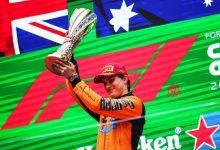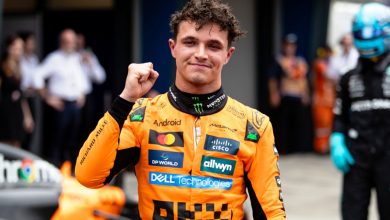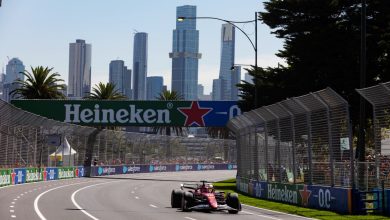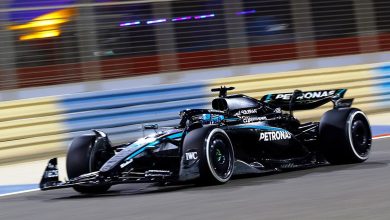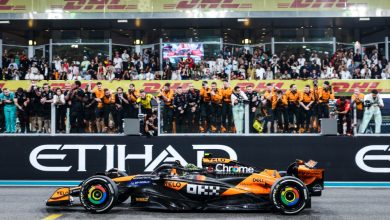Hamilton fastest on Friday;
Monza 7 Sept 2012: Lewis Hamilton topped the Friday afternoon timesheet in Monza and admitted he is relaxed about the pace of his rivals ahead of the Italian Grand Prix.
After the morning session was topped by Michael Schumacher, with a lap of 1:25.442, Hamilton took over in the afternoon, the McLaren driver touring the Autodromo di Monza in a time of 1:25.290. Afterwards Hamilton said he was comfortable with his car and the closeness of the competition at the Italian track where in FP2 the top five driver were separated by just 1500ths of a second.
“Lots of people had some very good long runs but we just need to focus on our job. I’m relaxed about it,” he said of the day’s running. “It’s a beautiful circuit stunning to drive. Incredibly high speed and when you get the flow right, it’s just such a great feeling.”
Hamilton added that there was more pace to find in his car but that it would be in terms of small improvements.
“You can always improve, maybe a little bit of time in sector one but trying to find that with the balance… we’re really fine-tuning it at the moment.” He said. “It has been the better Friday out of the two we’ve had since the break! It definitely has been a lot smoother today and I hope that continues for the rest of the weekend. Today’s been quite productive. It’s been quite smooth in terms of the set-up direction we’ve been going in. There are still things we need to improve on the car but generally it’s been a good day.”
Hamilton’s closest rival in the session was team-mate Jenson Button, who finished the session in second, just 0.038 adrift of the 2008 champion.
“Today we had a lot of good running on both tyres on high fuel and lower fuel,” he said. “It’s not too bad. We tried a few things this afternoon, some of which were positive and then one of the things we did, which we had to keep on for the whole session, wasn’t fantastic but it’s something easy to go back on.”
While Hamilton was unconcerned by the pace of the team’s rivals Button was more wary, particularly of Ferrari, who saw Fernando Alonso and Felipe Massa finish third and fourth respectively.
“Ferrari’s pace is very good,” said Button. “They’re very good, both cars. They’re very competitive on both tyres, especially on the prime tyre. There are quite a few cars that are quick, the Mercedes, the Lotus cars. It’s going to be an interesting weekend. It won’t be straightforward for any of us.”
FIA Press Conference 2 – Friday
TEAM REPRESENTATIVES – Franz TOST (Toro Rosso), Pat FRY (Ferrari), Eric BOULLIER (Lotus), Christian HORNER (Red Bull Racing), Monisha KALTENBORN (Sauber)
Franz, a new technical director. One has departed and a new one has arrived. First of all, can you explain what happened with Giorgio?
Franz TOST: First of all I want to thank Giorgio Ascanelli. He did a very good job over the last six years, when he was with us because we must not forget that he had to build up infrastructure at Toro Rosso. When he started there were around 20 engineers and today there are around five times the number. He did a really great job. We were quite successful. As you know in 2008 we won the first grand prix with Sebastian Vettel, therefore thank you very much for this. Now times have changed, we are looking forward to a new challenge and therefore James Key is on board with us.
So, what can you hope for from James in the short term with this year’s car and in the longer term with next year’s car, which presumably has already been started?
FT: First of all, this year’s car, we’ve arrived into September where we can’t expect so many changes. I think we will come up with some upgrades for the rest of the season, but there were planned and in project already before James joined us. But he is now very much involved in the design of the new car, which already started around two months. But nevertheless he will have hopefully a lot of influence over next year’s car.
Presumably you’re very encouraged to see what’s happening with Sauber, which was James’ last car?
FT: Sauber is doing very well. The car is very fast and hopefully he will do a similar good job, as he did at Sauber.
And the same engine of course?
FT: Exactly.
Pat, first of all, tell us about Alonso’s problems today?
Pat FRY: Well, this morning, obviously, he had an issue, which stopped us running a little bit early. This afternoon has been a bit of a messy afternoon for us. We had a problem with a brake system and finally a gearbox problem stopped us running right at the end. Fortunately, we managed to do all the long-run work with Felipe. We didn’t get the entire programme done with Fernando, but we answered the questions we needed to ask.
Was that quite a high mileage engine? And what about the gearbox, do you get a penalty for that?
PF: Gearboxes are free on Friday obviously and the engine was obviously a Friday engine at high mileage.
In terms of the performance this year, you’ve turned round a car that was not particularly competitive at the beginning of the season, particularly around Barcelona and the Mugello test. What did you do then and what can you do now? Was it modifications or was it set-up changes.
PF: Mainly modifications to the aero package. I think we made a reasonable step forward in Barcelona and we made another reasonable step forward in Canada. I mean, every race we bring new parts but I think those are the two steps that I suppose stand out when you look at the performance of all the teams. But I think we’ve still got a long way to go to be happy with our performance level.
And the aero package here: how is that working?
PF: Yeah, everything seems to be behaving sensibly. It’s a little bit of an extreme circuit here and I’m sure there will be different downforce level choices with people and it should make for an entertaining race anyway.
Eric, we’ve seen Romain Grosjean here. Presumably you’ve had quite a chat with him. What has he said and what have you said to him since last weekend?
EB: Nothing much to add to what had been said in the media here. Just to his clear understanding that is was a severe penalty he got and talking about the reason why and how we can change things to make his weekend a little bit easier to handle for him. Basically this kind of discussion.
Last weekend, Kimi at one point was complaining about lack of power on the radio…
EB: He was asking ‘can I have more’. During the race we have different strategies. We knew that Sebastian was too far in front of us to catch up and so we went into a fuel saving mode and obviously that’s changing a little bit the mapping and the performance of the engine. He was just hoping to be back to the normal fuel system.
Jerome D’Ambrosio steps in having done a few laps earlier on this year at Mugello, but only that. In retrospect would you perhaps give a reserve driver more laps, or maybe even a Friday for example?
EB: The plan was to give him a couple of Fridays and more over the whole season. But because of the performance we had to reconsider a little bit the strategy and ambition of the team maybe for this year. It’s always when something happens that you say ‘I should have done this differently’. Obviously I am happy with what he did bring. We gave him also a couple of runs with an old car, a three years old car in different demos and that helped him as well to keep a little bit some feeling with a Formula One. But yeah, if he would have a more mileage he would have fit a little bit better even if he did a good job today.
Christian, last weekend there seemed to an issue again about power. I’d like you clarify what it was all about – was it set-up or gearing or what the problem was last weekend for the Red Bull team?
Christian HORNER: The problem you’re referring to was?
At the top of the hill.
CH: Basically with the lack of running on Friday because it was obviously raining your gear ratio choice is made on Friday night and we elected to go quite aggressive with our top gear. With 20/20 hindsight we would not repeat that decision in a similar situation and we would go a bit longer. What was happening was once our drivers were getting in the DRS zone and opening their wing they were getting into the limiter and weren’t able to capitalise on the DRS. Therefore, with Sebastian, the progress that he made was coming back up the hill through Blanchimont into the chicane. He did a great job passing quite a lot of cars around the outside and inside in that last chicane.
That must have been very satisfying to get the result you did get given the problem in the traditional overtaking area.
CH: Yes, I think it was actually one of the best race I’ve seen Seb drive to be honest. His performance last week was very strong. It was great for the team to score points on a day when our main rivals weren’t on track because of the incident on the first corner from which everybody, thankfully, emerged unscathed.
It was a strong race, particularly by Sebastian. Our pace on Saturday we didn’t quite understand in qualifying over a single lap because we looked quick in the morning and then that performance eluded us in the afternoon. Our race p[ace on the Sunday was actually very strong. We were flexible with our strategy, we managed to make a one-stop work well, particularly for Sebastian. Mark’s strategy was a little bit more conventional but overall it was positive points for the team.
And you’ve got some good tracks coming up, some tracks where you’ve excelled in the past. What are your feelings about those?
CH: I think the one thing we’ve seen in 2012 is that past form is irrelevant this year. It’s impossible to predict what your form is going to be like from circuit to circuit. Obviously we arrive at each grand prix and we try to maximise the car and the package we have. This weekend is no different to that. Singapore is another challenge in itself, a bumpy, twisty street circuit compared to the long straights and flowing corners here at Monza. That’s the big challenge of Formula One is to try to be consistent across all 20 venues, of which we’ve got eight to go.
Monisha, last weekend you went from Heaven to Hell in a very short space of time. What sort of impact did it have on the team?
Monisha KALTENBORN: Well, we are used to these kind of situations where you think it’s looking good and it doesn’t quite work out. Until the formation lap it was really looking good for the team. We had a fantastic race weekend until then. One of the best qualifying positions so far for the team, and it all looked really good. Then suddenly on the formation lap, we see how things are billowing out and it ends up really badly. So, what we did then is analyse what happened on Kamui’s car and see where we can still improve. Because that’s important for us. We see quite often that if qualifying works out well, we have good race pace and then we can really get a lot of points home. That’s what’s we did. We took a lot of positives home from that weekend, that the car is very competitive, and we need to make sure that we don’t make mistakes during the race weekend.
Were you particularly looking at what happened on Kamui’s car? Sergio obviously got involved in the incident…
MK: Sergio really couldn’t do anything, he was just terribly affected by that incident. On Kamui’s car we had to find out why there was that smoke and why the start was not that good.
Any conclusion to that?
MK: We know now what happened, we analysed that. And whatever the team can do, we’ll definitely do.
In terms of your technical team, tell us how it’s working these days. It’s been like this since the start of the season, but you don’t actually have a technical director, do you?
MK: No, we don’t have a technical director, that was my choice. We have three main areas which we consider to be critical for the development of the car – which is the aero, the design and what we call the vehicle performance. Their heads are in this committee. They sit together and decide on a technical direction. If there are any other issues then we four, with me in there, sit in there and try to find the best solution. It seems to be working and it’s a bit of a history at Sauber that we’ve always had very strong heads of department and the people under them. It’s always been the backbone of the team and it works well.
QUESTIONS FROM THE FLOOR
(Barna Zsoldos – Nemzeti Sport) Franz, I would like to ask you to recall some memories of the 2008 Grand Prix – the whole emotion, the whole weekend. Was it a confirmation for you, and for Christian, that Seb is going to be a future champion?
FT: Let me say it in this way. We started already on Friday, if I remember right, to prepare the cars for Sunday under wet conditions because the weather forecast was quite clear: it said there was a high risk of rain. And I remember that we said to the drivers, ‘stay out, do as many laps as possible’, because here in Monza under wet conditions it’s a little bit different than on other tracks because their are not so many possibilities that the water can runoff and therefore you have exactly to know where to drive. Sebastian Vettel and Bourdais did a lot of laps and we found a good setup in those days. And then I was quite happy on Saturday during the qualifying when the rain didn’t stop. And then, of course, on Sunday, when it rained when the race was started under the safety car. Once Sebastian was in front I was quite convinced that he could at least finish the race within the first five positions. I didn’t think that he could win the race but then he did a fantastic job. And then the team also during the pitstops made a good job and then at the end fortunately we won this race. But we must not forget there were very special circumstances. We clearly could see in those days that Sebastian Vettel’s learning curve and his performance improved from race to race. And I was convinced that he could do a really good job at Red Bull Racing. That he won then the championship already in 2010 you couldn’t know in 2008. But that he will have a good future, this was quite clear for me.
(Dan Knutson – Honorary) Pat, looking ahead to Suzuka, what do you need to have a fast car there and how will your car go there?
PF: Well, I suppose it’s dominated by efficiency and aerodynamics. It’s just that we need to keep up the constant drive we’ve been doing all year, as everyone is, just to improve the efficiency of the car.
(Dieter Rencken – The Citizen) To the four team principal, 2014 obviously there’s a major change in engines. The four of you are customers of engines – in other words you don’t have teams producing your own – what sort of progress has been made on the costing issues and what are your expectations in this regard?
CH: I think 2014 is going to be an interesting year. The engine is radically different. I think that it’s important that the engine doesn’t become the crucial, single performance differentiator – I think that would be particularly unhealthy for Formula One and for the engine manufacturers involved. I terms of cost of supply I think the difficulty with introducing new technology and advanced technology such as the 2014 engine, it comes at a price. And I think all of the independent teams are very eager to know what that price is and what the impact of that price will be. I don’t think it’s the right market for Formula One to see an increase in costs. I don’t think that’s ultimately sustainable. But hopefully it won’t have an impact on the fiscal side.
MK: We have been very clear about our position. At the moment a lot of details are unclear on the technical side and also the price. We’ve also very clearly said that we don’t want to go down to those times many years ago where engines were so horrendously expensive. I think in the last year, in this whole movement with cost-cutting and the engine freeze which took place. Now costs have really gone down a lot and we don’t want to take three steps back again with this new engine and end up at a point which was there many years ago.
FT: It’s quite clear that this new powertrain in 2014 will increase the costs. It’s not possible to make it cheaper, as we get it now, because there’s a new engine, we have the new ERS system, there’s the new batteries and everything will for sure increase the costs. And 2014 will become an expensive year. Now the question, how is the depreciation in the following years? Just maybe to level the costs, on an acceptable amount. This we will see and I hope that we can negotiate this with the manufacturers, I hope the manufacturers will be as fair as they were in the past. And then I’m convinced that we will find a solution.
EB: I do share the same position. It’s a concern, the costs of the new powertrain. We expect either though the engine RRA or different discussions we can have with the engine manufacturers… you know it’s going to be reasonable… we don’t see new technologies is going to be difficult to bring the price down, cheaper than now – but if there is an increase we just expect a reasonable increase.
Q: (Andrea Cremonesi – La Gazzetta dello Sport) Pat, yesterday Michael Schumacher said that covered cockpits were necessary, they will be introduced in the future for sure. Do you agree with that or are there other options on the table from the Technical Working Group?
PF: Looking back at the start of last weekend’s race, it was a lucky situation. It could have gone very badly, so I think the whole of Formula One was very lucky. A flying car or a large piece of car flying in the air is still the one thing that we struggle to protect the drivers against. There’s obviously been quite a lot of research by the FIA which is still continuing. They’ve looked at the covered cockpits and then different roll cages as well, so I think that research just needs to continue really, as quickly as it can.
Q: (Andrea Cremonesi – La Gazzetta dello Sport) What is your opinion of the projected increase in fees paid to the FIA for next year?
EB: Well, as you said, it’s a potential increase. We have not been officially informed yet about this change by the FIA. If that’s the case, we obviously will need to understand why and what will be the justification for such an increase, because there is a massive difference, as you can understand, between the current level (and the future one).
CH: I think it’s important to understand what’s involved in the increase, what’s included within it, what we pay that’s external from the current entry, for example. There’s only been a brief discussion about it at the moment. I’m sure there’ll be further talks in the coming weeks.
MK: As Eric said, we’ve only been learning about this from the media. The FIA has not really got in touch with us so we have to wait and see what they really propose and what their intentions are but apart from that, I think the FIA is fully aware that there are many teams out there which are already in a financially challenging situation and if you put further burden on them like this – depending on the package – you should be careful about the situation.
FT: It doesn’t match so much with the cost reduction but we have to find out what is the reason behind this and we have to know more details and then we will sit together with the FIA and then we will see where we end up.
Q: (Naoise Holohan – Manipe F1) Given the successes of Fernando Alonso during the course of his career and how he’s driving this year, can I get the opinion of everybody on the question of him being the greatest driver of his generation?
CH: I think it’s always very difficult to compare drivers across generations. You have to look at the equipment at their disposal, who their competitors were at that time. Fernando, for sure, is one of the all-time great drivers in Formula One but I personally find it very hard to judge where and how you compare different generations. There are generations which we didn’t even see which only people as old as Bob (Constanduros, moderator) would remember and I think it’s very difficult to judge drivers from different generations.
EB: I do share what my colleague next to me has said. It’s clear that it’s difficult to judge and compare different generations. What we can say today is that in the career of a driver you have different phases and I would say that Fernando is at the top of his form today.
PF: He’s obviously an outstanding driver, isn’t he? I had the pleasure of working with him in 2007 and again now. I think I would agree that it’s hard to actually compare even drivers in different cars. What is the actual performance of the car? The only driver you can really compare to is your teammate because you have like-for-like tools. He’s certainly at the top of his game this year
FT: From the arithmetical point of view it’s Michael Schumacher because he won seven titles and then Fangio, Prost, Senna and because these drivers have done the best job or did the best job during their career and to compare drivers within different periods of time is simply not possible.
MK: As it has been said, each time was so different that it is indeed so difficult to compare, but I think it’s highly impressive in a season that despite all the different winners and things like that, Fernando has been so consistent, always just bringing the car home and getting all those points. It’s extremely impressive, the way he’s doing it.
Q: (Kate Walker – Girl Racer) Going back to the 2014 engines, in addition to the actual spec change, we’re going to see a reduction in the number of engines available to each driver from eight down to five, that at a time with no real track testing. Are you concerned that the 2014 championship may be determined by engine reliability rather than driver skill?
EB: Yeah. The concern is when you have a big change in the regulations is that you don’t want an engine reliability issue, especially when you are limited to five engines per driver. You don’t want to have an engine powertrain dominating compared with the others so there’s a lot of question marks which I think have been raised by the Technical Working Group and even different groups working with the FIA. We have to rely if possible on the regulator in the governing body to make sure that everything will be in place, to make sure that reliability of such issues are fixed for the beginning of the season, even if it’s not going to be easy to challenge for the engine manufacturers, but we have to believe everything has been planned at least.
CH: I think Eric has summed it up very well. I think the other key thing to remember is that technology will be very new. Basically 50 percent of the power will come mechanically and fifty percent of the power will come electronically and I think the technology will be very immature and then you’re talking about homologation of engines as well at the beginning of the season and I think it would be very easy to freeze in an advantage or a disadvantage which would be unhealthy for the sport, I think, so hopefully there will be some constructive discussion in the coming weeks to ensure that a performance advantage or disadvantage for a manufacturer of which potentially there will only be three, will be able to be addressed if somebody undershoots, particularly in the early years. It will all converge over time but as the technology is particularly immature there could be quite large variances, certainly in the first year or two.
Q: (Kate Walker – Girl Racer) Is that a discussion that is currently ongoing?
CH: I’m sure that in the Technical Working Group they are talking about it but it’s a challenging topic. It’s a difficult time to be introducing a new engine, obviously, under the financial climate that we currently have but that’s where we are and hopefully in the time between now and when the engine is introduced, measures can be made to ensure that not only costs but competitiveness of a power plant can be measured and controlled accordingly.
MK: Well, the risk is absolutely there and maybe we then have to also… or the engine manufacturers allow them certain activities next year regarding the reliability and maybe that could also have cost implications, positive ones, for us, so I think we have to be open to discuss that and look into that.
FT: The 2014 powertrain package will become a great great challenge from the technical side, because there are so many new factors which have to be taken into consideration. It’s not only the engine, it’s the air system, the batteries and it’s not only the reliability, it’s also the cooling. I personally fear that the field will not be as close as it is currently. I think that maybe one engine manufacturer will come up with a special solution and those cars will be far in front, as we saw in the turbo years. I just hope that the three manufacturers will come up with similar solutions and that the output of the powertrain will be at a similar level, that we also will see in 2014 a nice and interesting Formula One season as is currently the case.
PF: I think the 2014 power unit is a very interesting technical challenge, lots of complication, and the drive to improve performance and efficiency is going to be massive. Dealing with reliability is certainly not an insignificant problem. There were certain teams which want to run an engine in an old Formula One car. That has been discussed at the TWG – I was keen to do that because I think it will help improve the reliability, running it in a proper car with all proper G-loading and everything. That was vetoed or voted out, whatever the right term is, so we’re left trying to answer the questions on the dyno. We will answer some of the questions but we certainly won’t answer all of them. There will be an element of risk when you go into the February testing, when you’re going to have three tests to sort it out. If you’ve got a major problem, you’re in a bit of trouble. Best we get our design right to start with, I suppose.
Q: (Alan Baldwin – Reuters) Eric, there have been a couple of stories about Robert Kubica getting back into a rally car and trying that out. Has there been any kind of contact with you over the last few months? If he were to get in touch with you, would you be at all interested in giving him a ride in one of your older cars for old times’ sake?
EB: It’s a long time that we haven’t been talking about this. No, I did read in the press, like you, that he was doing some rally and actually he’s supposed to do a rally next weekend or something like this, but we don’t have much contact. I have contact with his management but nothing else. I’ve not been updated about his current state for a long time.
Q: (Gary Meenaghan – The National) Eric and maybe all of you; in this era of no end of season testing, how important is the simulator?
EB: You know the simulator has now reached a very good level of detail, to get the drivers familiar, to bring out the real use of a simulator which is not related to the driver. It’s true that in the position today, where some drivers are stepping into Formula One in the last three or four years with thousands of kilometers of testing, to generally get used to the team with the process of Formula One, with the procedure of the car, with everything, it’s easy, obviously, to step into Formula One. With the current format, now, most of the drivers now have to step in with zero miles under their belts which is a bit tricky. But there is an economic reality as well. Testing costs a lot of money, a lot of resources as well, because not only money, we are already having a busy calendar during the season and we have set up – Lotus F1 are set up to have one crew for the whole season, so adding extra testing would obviously have consequences on the resources, so the question is up in the air, let’s say. Is the balance today good enough with simulator and with a few test days at the end of the year? I don’t know, I don’t have the answer. I know that the balance today is working but is it fair or not?
FT: Testing is very very expensive. If you want to go out for a test, you need your own test team. We cancelled the test team because of the costs three years ago. I think this was the correct decision. Regarding the young drivers, as Toro Rosso is a young drivers’ team, normally we do it in this way that young drivers which are coming into Formula One get the possibility to run on Fridays in the morning, and I think this is a good possibility to step into Formula One, to learn everything. And every team can do this. It’s not only restricted to young driver teams and therefore I think the current balance which we have from the regulation side is a good one.
Q: (Christian Nimmervoll – Motorsport-total.com) Christian, you mentioned before a potential freeze of an engine advantage when the engines come in in 2014. Is that one of the reasons why Red Bull is so keen for an engine RRA to be introduced with a chassis RRA, possibly in 2013?
CH: Er, no. The reason that we said that there should be… if an RRA is to come in in full force and policed by the FIA it should encompass all aspects of the car of which the engine and power unit is a significant part, because some teams in Formula One belong to automotive or are automotive subsidiaries that produce both chassis and engines and obviously some resource will come between chassis and engine and it’s impossible with a chassis-orientated RRA to eliminate elements and treat, in our opinion, all parties transparently and fairly. Our view is that if you’re going to look at a resource restriction of any form, you’ve got to look at the formula in its entirety rather than cherry picking certain elements, and obviously the engine is a key cost driver and therefore should be included within any overall package rather than just, as I say, looking to cherry pick certain items and cost drivers.
Q: (Dieter Rencken – The Citizen) Christian, your colleague Helmut Marko, if he was reported correctly, stated that he felt that the Sauber was the fastest car out there. Given that it’s a James Key car, given that James is going across to Toro Rosso, are you concerned that possibly Toro Rosso will produce a faster car than you next year? And would you invoke drink orders in that case?
CH: I think the Sauber has been a very good car this year. I think it’s been clear at different races that they’ve had very good pace, including less than a week ago in Belgium. The changes in the regulations this year were significant and it seems to have concertina-ed the field significantly and that also includes the likes of Williams, Lotus have made a big step as well this year, so you turn up to a Grand Prix not knowing who is actually going to be competitive, how competitive your own outfit is going to be. I think James Key has done a good job previously, not just at Sauber but the teams that he’s been at prior to that and I think it was an obvious choice for Toro Rosso when they were looking to restructure, to include James within their line-up. I think as far as the future is concerned, I’m sure he is going to be looking to make his mark there and the teams are open to race. Sebastian Vettel won his first race here in 2008 in a car that was designed in Milton Keynes and run by Toro Rosso, but the teams were free to race each other and that will continue to be the case.
Q: (Dieter Rencken – The Citizen) Franz when I visited you in May, you were speaking about your expansion plans and you were going to move into new factories etc during the shutdown. What sort of progress was made there?
FT: Step one of our building is finished now and it’s mainly for the composite department and we moved the composite department into the new building during the shutdown and fabrication has already started. You are invited to come there to see it. It looks good.
Ends


